Not every garden needs acres of soil to be abundant. With the right plants, you can grow food — and beauty — straight up into the air. Berry-producing vines are masters of this, twining around trellises, fences, and arbors to transform small spaces into living walls of color and flavor.
Some of these berries are sweet treats, others are wildlife favorites, and a few are best admired rather than eaten. Whether you’re working with a balcony, a courtyard, or a backyard, there’s a berry vine out there ready to climb its way into your space.
Below is a collection of 20 vine-growing berries to inspire your next vertical gardening adventure.
1. Grapes
Safety: Edible
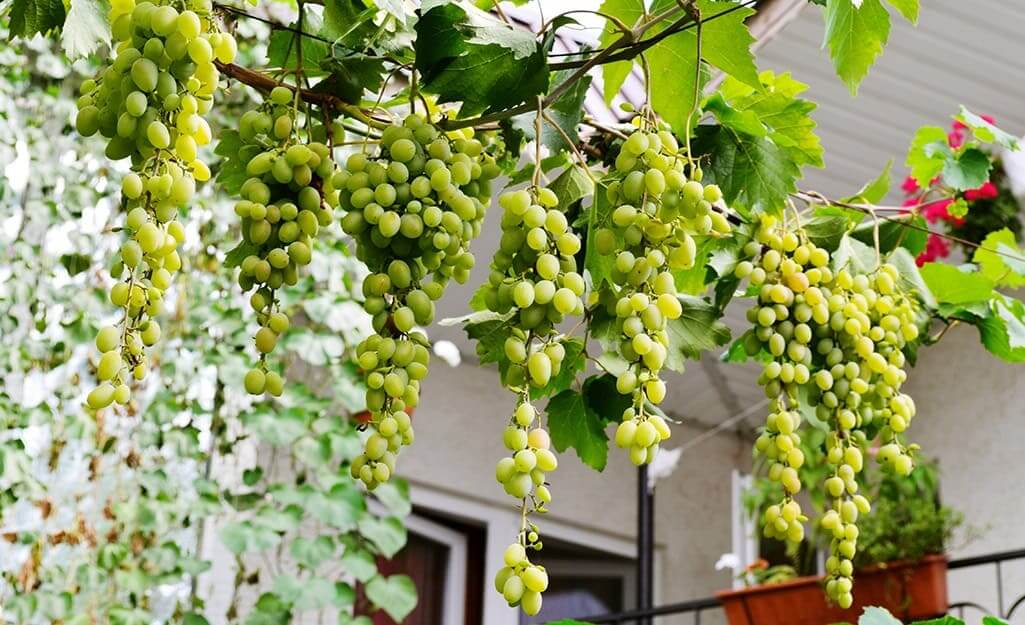
Grapes are sweet, juicy berries that grow in tight clusters on woody vines. They come in many colors — green, red, purple, black, and even pink — with “white” grapes actually being pale green. These berries love sunny spots, moderate rain, and well-drained, fertile soil. Grapes can be eaten fresh, dried into raisins, or turned into juice and wine.
2. Kiwi
Safety: Edible
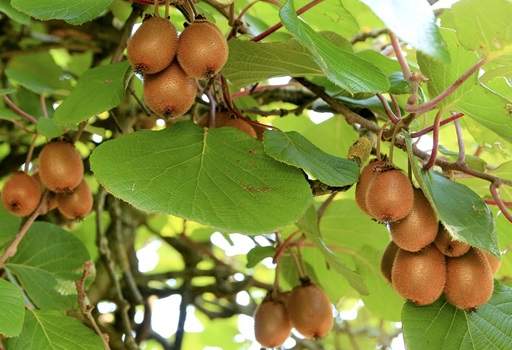
Kiwi, also known as Chinese gooseberry, is a small, sweet-tart berry that grows on climbing vines. Native to China, it has a fuzzy brown skin, bright green or golden flesh, and tiny black seeds you can eat. Juicy and refreshing, kiwi is rich in vitamin C, plus potassium, vitamin K, and vitamin E, which help support health and immunity. It grows best in temperate climates with cool nights and mild days, where steady weather brings out its full flavor. This vine fruit is both tasty and nutritious, making it a favorite for snacking, salads, and desserts.
3. Passion Fruit
Safety: Edible
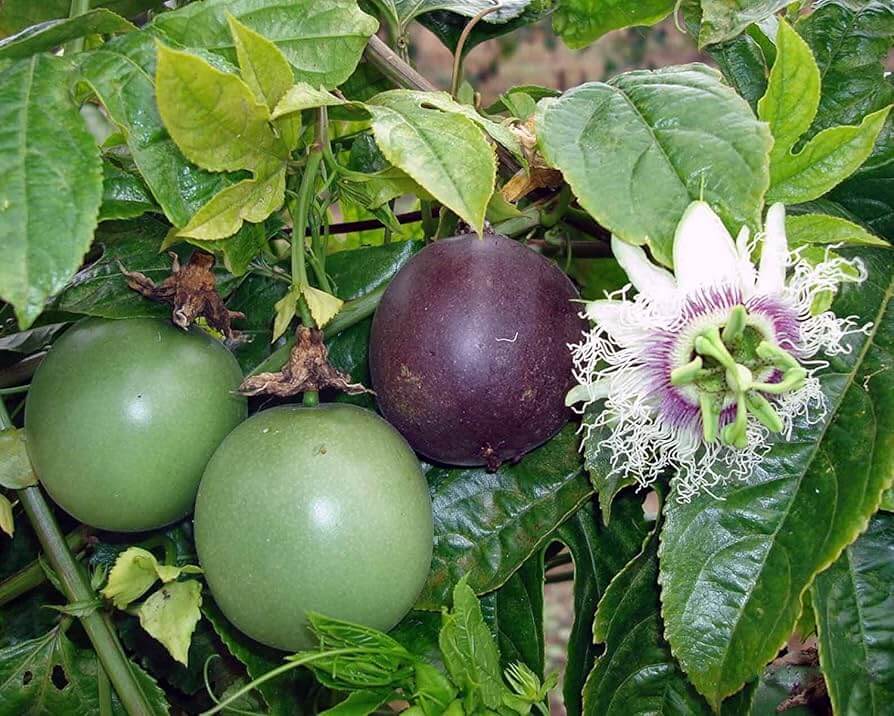
This tropical vine twines and climbs quickly, covering fences or trellises with striking flowers before producing round purple or yellow fruit. Inside, the pulp is juicy, aromatic, and packed with edible seeds, offering a mix of sweet and tart flavors. Passion fruit thrives in warm, sunny places and, in tropical regions, can give fruit almost all year. In cooler areas, it’s planted after frost and may take more than a year before the first harvest. Both beautiful and productive, it’s a favorite for fresh eating, drinks, and desserts, adding a burst of flavor and color wherever it grows.
4. Dewberries
Safety: Edible
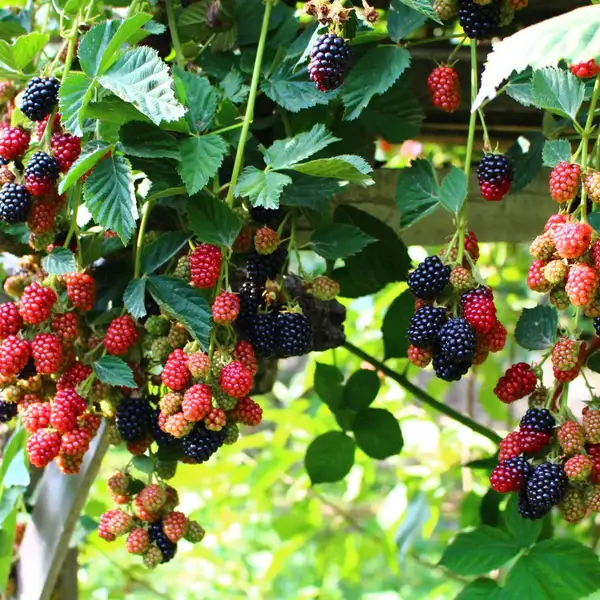
Dewberries are low-growing vines in the blackberry family, spreading along the ground rather than standing upright. They tangle into thickets with slender, thorny, red-haired stems and can spread quickly through roots and seeds. The berries look like small blackberries but are often purple-black and slightly softer, with bigger, tougher seeds. They ripen in spring or early summer and are sweet-tart when eaten fresh. Because they grow on trailing vines, they often sprawl over open ground, fences, or low shrubs, making them easy to forage if you don’t mind the thorns. Dewberries are delicious fresh, in pies, jams, or desserts.
5. Schisandra Berry
Safety: Edible
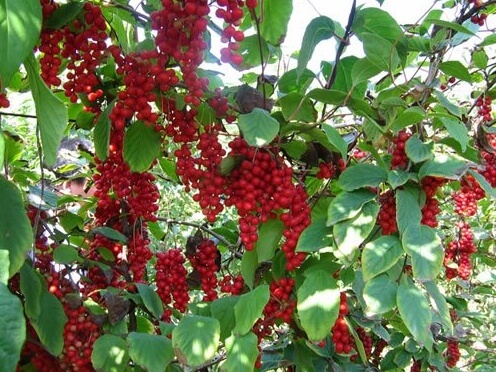
Schisandra is a hardy vine that grows in cool climates, producing clusters of bright red berries. Known as the “five-flavor berry” in China, it offers sweet, sour, salty, bitter, and pungent tastes all in one bite. The berries can be eaten fresh, dried, or sun-dried, and are often made into teas, juices, wines, and tinctures. In traditional Chinese medicine, they’re valued for their energizing and health-boosting qualities. Schisandra vines prefer partial shade and well-drained, moist soil, making them easy to grow in the right conditions. Their unique taste and striking look make them a special find on any berry vine list.
6. Loganberry
Safety: Edible

The loganberry is a hybrid of a raspberry and a blackberry, producing long vines covered in large, cone-shaped berries. When ripe, they turn deep purple and have a juicy, tart flavour. They can be enjoyed raw, though many people use them for jams, desserts, and baking. Loganberries ripen from midsummer into autumn, often showing flowers and fruit at the same time. They thrive in sunny, well-drained soil and need support such as a trellis or wires to climb. With good care, these hardy vines can produce generous harvests year after year, rewarding growers with both beauty and flavour.
7. Youngberry
Safety: Edible

Deep purple and bursting with juice, youngberries grow on long, thorny vines that return year after year. This early-ripening fruit is the result of crossing a blackberry–raspberry hybrid with a dewberry. They thrive in sunny, well-drained soil enriched with organic matter and need space to spread without disturbance. Known for their smooth texture and fewer seeds, youngberries are ideal for turning into jams, jellies, syrups, and sauces. Their softness means they break down quickly when cooked, creating rich, flavorful toppings for pancakes, cheesecakes, or ice cream, while staining everything they touch with their intense, berry-colored juice.
8. Boysenberry
Safety: Edible
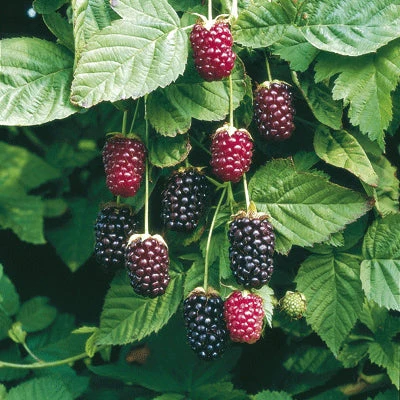
Boysenberries are large, sweet, dark purple berries that grow on long, trailing vines. They are a hybrid of loganberries, raspberries, and blackberries, first made famous by Knott’s Berry Farm for jams and desserts. The plants thrive in sunny spots with rich, moist, slightly acidic soil and benefit from a trellis to support their canes, which can reach up to 20 feet. Ripening in late spring, these berries are loved for their juicy flavor and are a favorite in pies, sauces, and fresh eating.
9. Wineberry
Safety: Edible
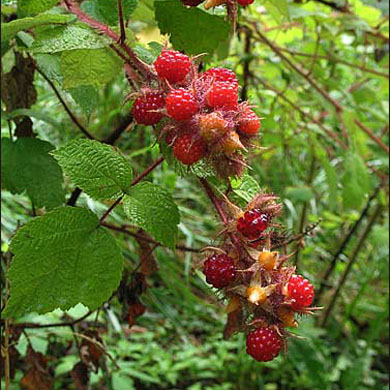
Growing on long, arching vines, wineberries produce clusters of bright red fruits with a sweet-tart bite. Originally from Asia, they now flourish in North America, often spreading quickly and crowding out native plants. The canes, which can reach 9 feet, are covered in fine red hairs that help protect them. Found along trails and forest edges, these berries are enjoyed fresh, in baked treats, or blended into drinks. Their flavor is delightful, but their invasive nature means they need careful control.
10. Tayberry
Safety: Edible
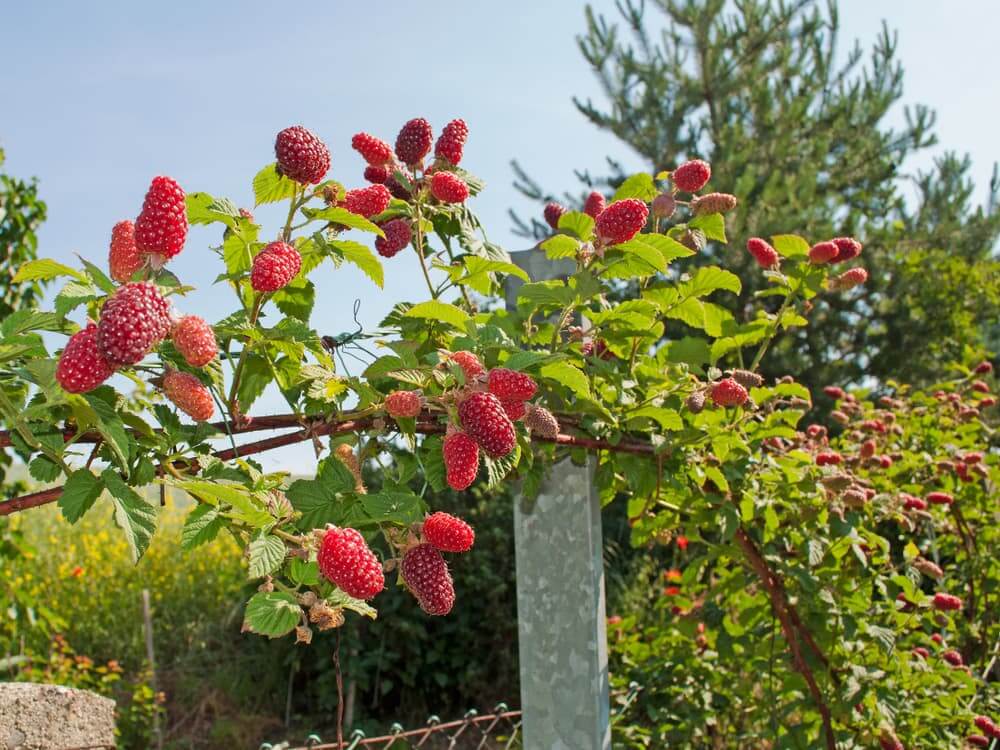
A cross between blackberry and raspberry, tayberries grow on long, trailing vines that need support. Their deep red fruits are soft, sweet, and slightly tangy, making them a summer treat. Because the berries are delicate, they’re always picked by hand, often with a bit of stem attached to keep them intact. They aren’t widely grown commercially, so finding them can feel like discovering a rare gem. Planted in autumn or early spring, these vines can be multiplied by letting a cane tip touch the soil and root naturally.
11. Pepper Berry
Safety: Edible
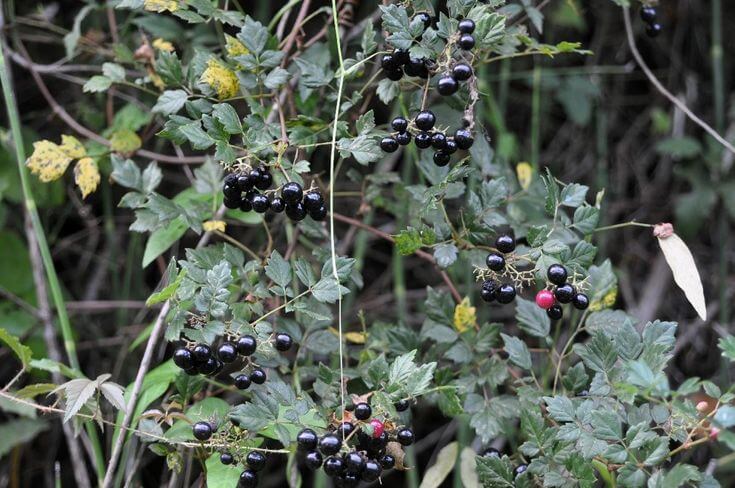
Pepper berries grow on woody vines or shrubs, turning from red to glossy black when ripe. These spicy fruits, along with the leaves, are valued for their strong, peppery flavour that works well in sauces, curries, cheese, and salad dressings. Flowers appear in spring and only plants with both male and female vines produce berries in autumn. The dried berries are often used as a native substitute for black pepper, while fresh ones can be frozen to keep their punchy taste for longer.
12. Greenbrier Berry
Safety: Edible (with caution)

Greenbrier is a tough, woody vine that climbs with curling tendrils and has stems armed with sharp prickles. Its glossy, heart-shaped leaves stand out against clusters of bluish-black berries that ripen in late summer to early autumn. While some parts, like the young shoots and roots, have been eaten or used in traditional remedies, the berries are not a common food and should be approached with caution. Greenbrier vines provide food for wildlife and can be found twining through forests, hedges, and thickets year after year.
13. Magnolia Berry (Five-Flavor Fruit)
Safety: Edible
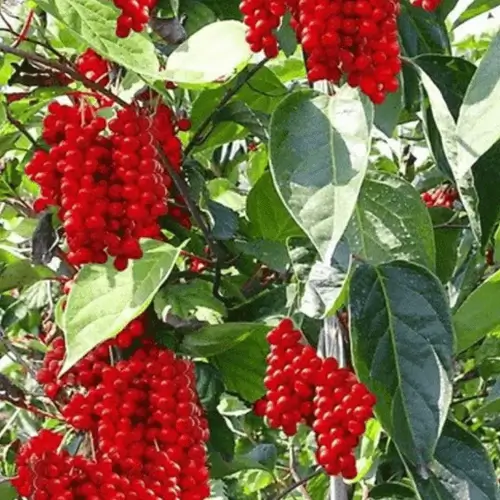
Magnolia berry, also called five-flavor fruit, grows on a woody vine and is native to China, Korea, Russia, and Japan. The vine produces clusters of bright red berries in late summer, each said to hold five distinct tastes—sweet, sour, salty, bitter, and pungent. It climbs over supports in forests or gardens and attracts bees when in bloom. Traditionally used in East Asian herbal remedies, it is valued for both its flavor and health benefits. Hardy and low-maintenance, this vine can thrive in well-drained soil and sheltered, sunny spots.
14. Virginia Creeper
Safety: Toxic
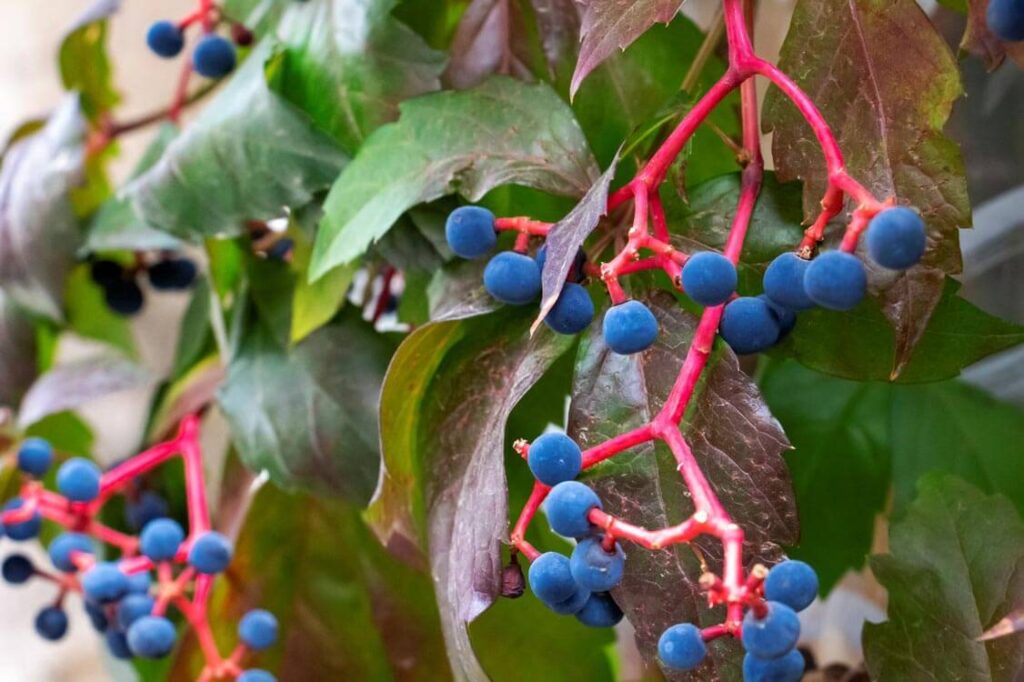
Virginia creeper is a fast-growing woody vine that can climb trees, walls, and fences using tendrils with sticky tips. Native to North America, it is often found in woodlands, along streams, and on rocky slopes. Its five-part leaves turn brilliant red in autumn, making it a popular ornamental plant. In summer, it produces small green flowers, followed by dark blue berries that are poisonous to humans but eaten by birds. This hardy vine can grow up to 50 feet, spreading quickly in both wild and garden settings.
15. Porcelain-berry
Safety: Toxic
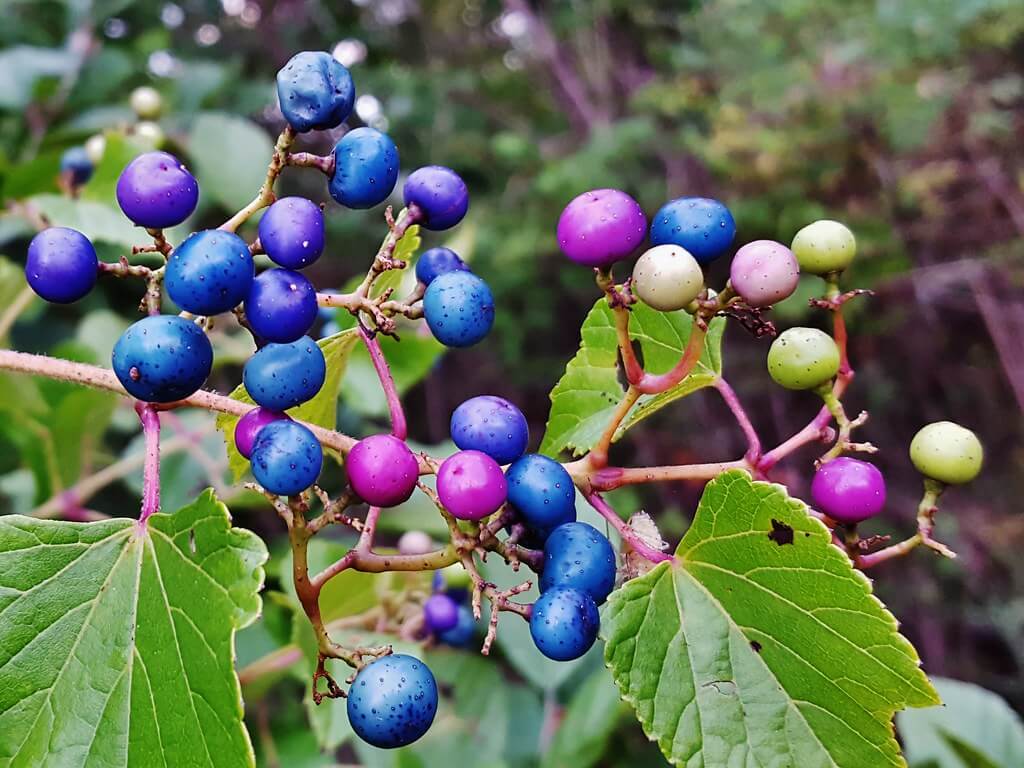
Porcelain-berry is a fast-growing vine from Asia that can climb up to 20 feet, covering trees, fences, and ground. It spreads quickly, with birds and animals eating its berries and spreading the seeds. Its heart-shaped, toothed leaves can look like grape leaves, but its stems have smooth bark and a white center. In summer, it blooms with small white flowers, followed by berries that change color from white to yellow, green, lilac, or bright turquoise. It often invades shady, damp spots, crowding out native plants.
16. Poison Ivy
Safety: toxic
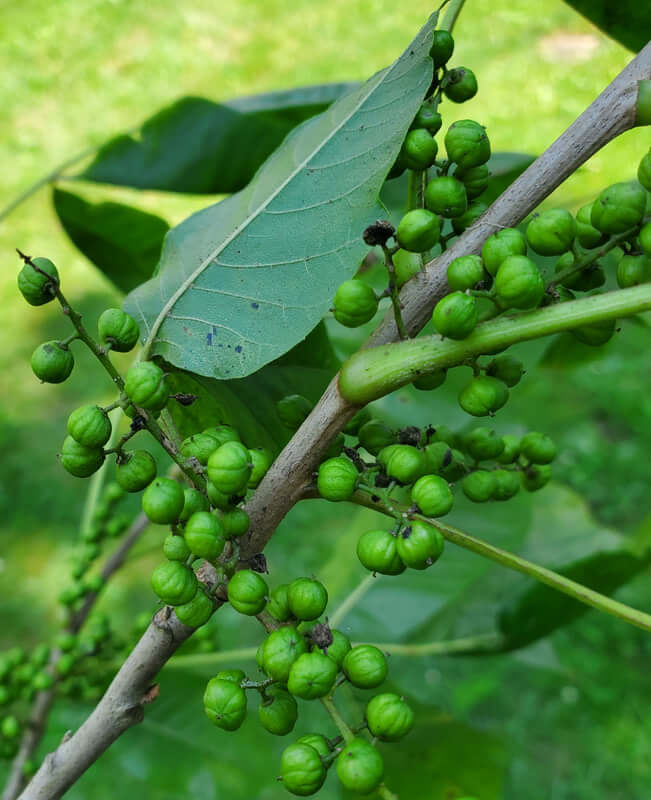
Poison ivy is a climbing or trailing vine that can also grow as a small shrub. It has clusters of three pointed leaflets, which may be shiny or dull, and change color with the seasons. In late summer, it produces small, grayish-white berries that birds eat, spreading the seeds. Found along fences, forest edges, and riverbanks, it can climb high into trees. All parts of the plant contain an oily sap that can cause itchy skin rashes, so it should never be touched.
17. Oriental Bittersweet
Safety: Toxic

Oriental bittersweet twines around trees and shrubs, sometimes reaching 60 feet. It spreads by root sprouts and by birds eating its fruit. Its leaves are round and finely toothed. In spring, it produces small greenish flowers, followed in autumn by bright yellow seed capsules that split open to reveal red berries. The vines grow aggressively, often strangling trees and blocking sunlight. While the berries are eaten by wildlife, they are not safe for people.
18. Pepino Melon
Safety: Edible
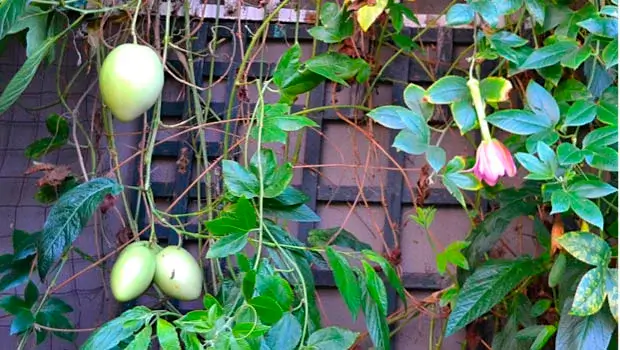
With smooth, pale skin patterned in purple streaks, the pepino melon grows on a small, sprawling vine. Its oval fruits taste mildly sweet, like a mix of melon and cucumber. Native to South America, it thrives in sunny, warm areas and is often grown in gardens for both beauty and flavor. The vine produces small, purple-and-white flowers before the fruit appears. Pepino melons are enjoyed fresh, in salads, or as a dessert fruit.
19. Chayote
Safety: Edible
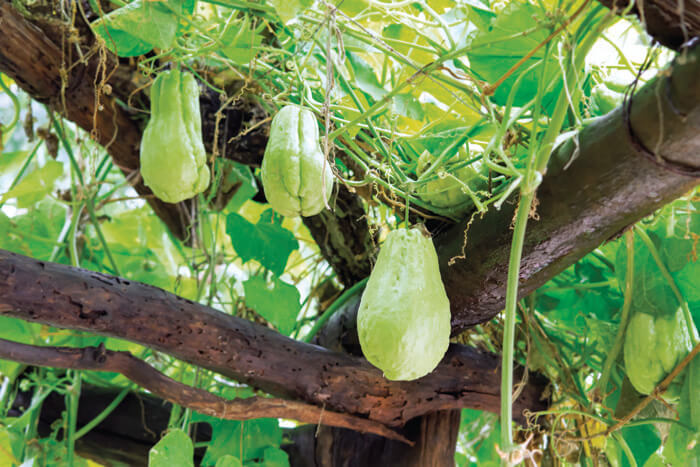
This climbing vine produces light green, pear-shaped fruits with crisp, mild-tasting flesh. The shoots, leaves, and even the tuberous roots can be eaten. Chayote grows best in warm climates, often trained along fences or trellises to support its rapid growth. It produces small, pale yellow flowers before fruiting. Popular in many cuisines, it can be eaten raw, boiled, stuffed, or added to soups and stews.
20. Carolina Moonseed
Safety: Toxic
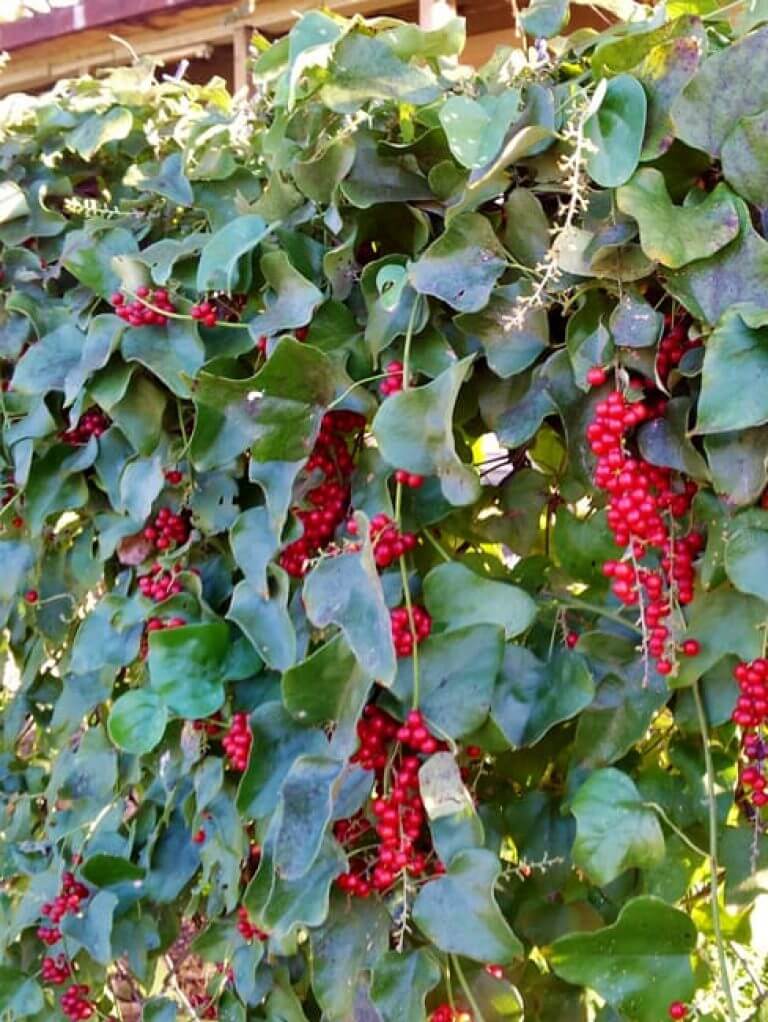
Carolina moonseed is a twining vine often found in thickets, along streams, or climbing over shrubs. Its glossy green leaves are shaped like hearts, and in summer it bears small greenish flowers. By late summer to fall, it produces striking clusters of bright red berries, each with a flat, crescent-shaped seed inside—hence the name “moonseed.” Although birds may feed on the fruit, it is poisonous to humans and should never be consumed.
